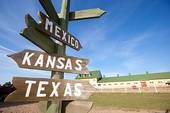Seattle: The Wild Wild West When It Comes to Signs?
 According to a recent Crosscut article Seattle is “the Wild West” for outdoor signage, where bigger, brighter, bolder, and brazenly illegal signs are polluting the streetscape. The article focuses on the proliferation of wall-covering vinyl signs and how the City has allowed these signs through a loophole in the sign ordinance. The article concludes that the proliferation of wall-covering signs will lead Seattle into a dystopic and generic future that will rob Seattle its urban character. But what about the important role signs play in keeping a city fresh with new ideas and new products? Assuming the City can wrangle the signage cowboys, do wall-covering signs have a place in downtown Seattle?
According to a recent Crosscut article Seattle is “the Wild West” for outdoor signage, where bigger, brighter, bolder, and brazenly illegal signs are polluting the streetscape. The article focuses on the proliferation of wall-covering vinyl signs and how the City has allowed these signs through a loophole in the sign ordinance. The article concludes that the proliferation of wall-covering signs will lead Seattle into a dystopic and generic future that will rob Seattle its urban character. But what about the important role signs play in keeping a city fresh with new ideas and new products? Assuming the City can wrangle the signage cowboys, do wall-covering signs have a place in downtown Seattle?
Most wall-covering signs in downtown Seattle are not considered to be billboards. The City has limited the total number of billboards citywide to a fixed number, i.e. before a new billboard can go up, on has to be taken down somewhere else. This limitation on new billboards has driven commercial sign makers to seek other ways to bring their products into the city, particularly downtown. Some of the new wall-covering signs were permitted under a provision in the Seattle sign code that allows each business in downtown zones to install an on-premise wall sign with no maximum size. Though the purpose of the on-premise sign is to advertise the business, the City has interpreted the rule to also allow the business to advertise products or services offered by the business, such as a bar advertising a specific brand of beer. The Crosscut article cites egregious abuses of this provision, such as an advertising company who installed an on-premise sign advertising Starbuck’s Frappuccinos, claiming it was an on-premise sign because they handed out vouchers for free Frappuccinos. Clearly this is a stretch. The sign in question is a billboard masked as an on-premise sign.
The Council recognizes the City’s sign code needs some work, and has plans to begin hearings on revising the code late this year or early next year. The City has a responsibility to create rules and policies that avoid the kind of creative code interpretations that have frustrated many citizens, while gaining windfalls for commercial sign businesses who charge rents for signs with questionable legality. However, assuming such signs are installed legitimately, downtown Seattle is exactly the setting where we should welcome such bold and bright signage. Seattle cares about its built environment and has carefully crafted design review guidelines that foster an architecturally interesting pedestrians-friendly urban fabric. Most blocks have continuous façades with no gaps between buildings. Blocks containing empty lots or surface parking lots allow views of surrounding blank walls. These blank walls will disappear from view if and when the lot is ever developed, though many may remain visible for years, if not decades. In the mean time, temporary signs placed on these walls provide a source of visual interest that can be updated to remain fresh. Some of downtown’s blank walls have been canvases for signage for generations.
The City’s sign code should reflect its intent to enhance the visual environment of the City, while also providing a means to convey information about a business or public interests. Downtown is an appropriate place for large and colorful signs, but the City should create policy that can be applied fairly without the need for “Wild West” tricks and sneaky interpretations.


No comments yet
Start the discussion by using the form below